Sorry Kroger, But the Truth Isn’t Always So Simple
Supermarket chain’s launch of Simple Truth products was brilliant, but the pouch packaging doesn’t live up to the brand premise.
April 27, 2022

The biggest threat to Whole Foods' dominance in the natural products business is not Sprouts or Natural Grocers. It’s that bastion of legacy grocery sales, Kroger. The Simple Truth brand, launched in 2012, now generates well over $2 billion in sales annually. For reference, that’s more than one third of the total sales for the entire Sprout’s chain, and better than twice the size of Natural Grocers.
Kroger did three things right. First, they created a standalone brand family that has no relationship to its other store brands, or even to Kroger itself. Second, they priced these organic (Simple Truth Organic) and additive-free (Simple Truth) products at a premium to both their store brands and national brands. Finally, they introduced products fairly slowly, building on the momentum created by the natural food specialty stores. Ultimately, shoppers no longer had to go to Kroger for staples and Whole Foods for organic celery or peanut butter. They only had to go to Kroger. Brilliant.
Let’s review the on-pack messaging.
However, I’m afraid that the packaging simply does not live up to the brand premise.
I found this package of nutritional yeast seasoning in my pantry. See the little “Free From*” blurb at the top right of the white square? It took me awhile to find the reference that the asterisk was referring to – on the very bottom line, in mouse type, on the other side of the pouch. It sent me to the Simple Truth website, where there was no mention of what additives were not in this particular product, or any Simple Truth product. I finally found a page telling me that Simple Truth products are free from 101+ artificial preservatives and ingredients. But it didn’t tell me which ones!
OK, what should I do with the pouch when it’s empty? There is no resin identification code (RIC) on the package. And there’s no How2Recycle symbol. So, I went back to the website and found the recycling page. It told me that Kroger is turning soft plastic packaging from their brands into playgrounds!

But first, I had to sign up with TerraCycle in order to collect, pack, and ship my used pouches to them.
I also learned on TerraCycle’s Kroger webpage that enrollment isn’t guaranteed and that if the program is full, I will be put on a waitlist.
I guess there isn’t much demand for the stuff that TerraCycle handles.
The final straw in the recycling mess was that my nutritional yeast product was not pictured or listed as being part of the program, even though similarly packaged items were listed.
The big question: How will consumers react?
If I’m confused and frustrated, what would the typical well-meaning customer think or do?
The simple truth, from a sustainable packaging perspective, is that I will throw the empty pouch in the trash. Otherwise, it will probably contaminate my residential recycling stream. I’m certainly not going to waste my time and our collective energy resources by sending this virtually weightless pouch to TerraCycle, which will probably do the same thing with it that I did. (Besides, they may not even accept me into their program!)
Here’s the moral of the story: Make sure that the sustainability messages that your packaging delivers to consumers, both overtly and covertly, are in line with your brand positioning, messaging, and story. That’s the simple truth of the matter.
Robert (Bob) Lilienfeld has been involved in sustainable packaging for 25 years, working as a marketing executive, consultant, strategic planner, editor, writer, and communications expert. He’s President of Robert Lilienfeld Consulting, working with materials suppliers, converters, trade associations, retailers, and brand owners. He is Executive Director at SPRING, The Sustainable Packaging Research, Information, and Networking Group. You can also write him at [email protected] or visit his LinkedIn profile.
About the Author(s)
You May Also Like




